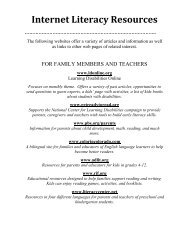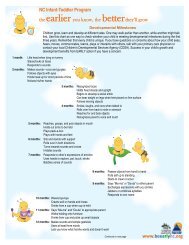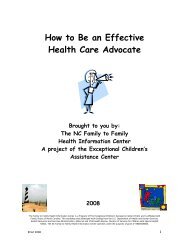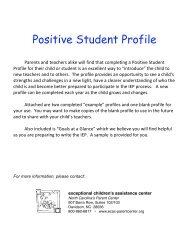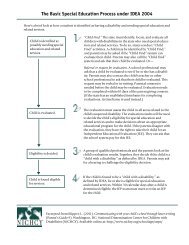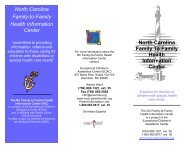Questions and Answers about IDEA - Exceptional Children's ...
Questions and Answers about IDEA - Exceptional Children's ...
Questions and Answers about IDEA - Exceptional Children's ...
Create successful ePaper yourself
Turn your PDF publications into a flip-book with our unique Google optimized e-Paper software.
1.800.695.0285(Voice/TTY)nichcy@aed.orgwww.nichcy.org<strong>Questions</strong> <strong>and</strong>Answnswers <strong>about</strong> <strong>IDEA</strong>:Pururposes<strong>and</strong> Key y DefefinitionsMore than 6.8 million children with disabilitiesin our public schools receive special education <strong>and</strong>related services as part of their publicly fundededucation. 1 But what is special education? What arerelated services? Who’s considered a child with adisability? This Q&A is designed to answer thesequestions—looking in detail at the m<strong>and</strong>ates <strong>and</strong>requirements of our nation’s special education law,the Individuals with Disabilities Education Act(<strong>IDEA</strong>), as amended in 2004.Read on, if you’d like to find out thepurposes of <strong>IDEA</strong>, as established byCongress in Public Law 108-446, as wellas how four of <strong>IDEA</strong>’s key terms aredefined in the final Part B regulationspublished in 2006. Those terms are:• free appropriate public education(FAPE);• child with a disability;• special education; <strong>and</strong>• related services.Table of ContententsA—<strong>IDEA</strong>’s Purposes 2B—Key Definitions 3The Q&A series presents components of <strong>IDEA</strong>separately to lighten the reading load. However, it’scritical to underst<strong>and</strong> that the law itself is oneintegrated whole of interweaving requirements. Noone part exists without the influence <strong>and</strong>reinforcement of the other parts. Taken together,<strong>IDEA</strong>’s provisions offer comprehensive guidelinesthat States <strong>and</strong> school systems use to determine howspecial education <strong>and</strong> related services are madeavailable to eligible children withdisabilities. You’ll find theQ&As on <strong>IDEA</strong> series onNICHCY’s website, at:www.nichcy.org/EducateChildren/Pages/QAseries.aspxWe’ve used the word“you” to speakdirectly to parents<strong>and</strong> families in thisQ&A, but the detailswill also be useful toprofessionals whowork with children <strong>and</strong>youth with disabilities <strong>and</strong>their families.April 2009National Dissemination Center for Children with Disabilities1825 Connecticut Avenue N.W., Suite 700 • Washington, DC 20009NICHCY: www.nichcy.org 1 1: Purposes, Definitions, Evaluation, Eligibility
★A—<strong>IDEA</strong>’s s PururposesWe’d like to start our Q&A series on <strong>IDEA</strong> bytaking a brief look at <strong>IDEA</strong>’s purposes, for theyunderpin <strong>and</strong> guide its many detailed requirements.Those purposes have their roots in the past, whenchildren with disabilities were often excluded fromschools. This history can be clearly seen in theFindings that Congress states at the very beginningof the law, as most recently amended in 2004.Public Law 108-446 states:FINDINGS.—Congress finds the following:(1) Disability is a natural partof the human experience <strong>and</strong>in no way diminishes the rightof individuals to participate inor contribute to society.Improving educationalresults for children withdisabilities is an essentialelement of our national policy ofensuring equality of opportunity, fullparticipation, independent living, <strong>and</strong>economic self-sufficiency for individualswith disabilities.(2) Before the date of enactment of theEducation for All H<strong>and</strong>icapped ChildrenAct of 1975 (Public Law 94–142), theeducational needs of millions of childrenwith disabilities were not being fully metbecause—(A) the children did not receiveappropriate educational services;(B) the children were excluded entirelyfrom the public school system <strong>and</strong> frombeing educated with their peers;(C) undiagnosed disabilities preventedthe children from having a successfuleducational experience; or(D) a lack of adequate resources within thepublic school system forced families tofind services outside the public schoolsystem. 2These words reveal why <strong>IDEA</strong> was originallypassed in 1975 as Public Law 94-142. Then, it wascalled the Education for All H<strong>and</strong>icapped ChildrenAct <strong>and</strong> gave grants to States for the education ofchildren with disabilities. Since then, it has beenamended many times, while always maintaining itsoriginal purpose—to ensure that children withdisabilities have access to a free appropriate publiceducation.In August 2006, the U.S.Department of Education releasedfinal regulations for the amended<strong>IDEA</strong> passed by Congress in2004. The regulations officiallystate that the major purposes of<strong>IDEA</strong> are:• to ensure that all children withdisabilities have available to them a“free appropriate public education”that emphasizes special education <strong>and</strong> relatedservices designed to meet their unique needs <strong>and</strong>prepare them for further education,employment, <strong>and</strong> independent living;• to ensure that the rights of children withdisabilities <strong>and</strong> their parents are protected;• to help States, localities, educational serviceagencies, <strong>and</strong> Federal agencies provide for theeducation of all children with disabilities; <strong>and</strong>• to assess <strong>and</strong> ensure the effectiveness of effortsto educate children with disabilities. 3Within these purposes, you can see several keyterms—children with disabilities, free appropriatepublic education, special education, relatedservices—all of which are defined within theregulations. This Q&A will share those definitionswith you. They’re important to know, because theyNICHCY: 1.800.695.0285 2 <strong>Questions</strong> <strong>and</strong> <strong>Answers</strong> <strong>about</strong> <strong>IDEA</strong>
drive how States design their own special educationpolicies <strong>and</strong> procedures, including their governinglegislation.★B—Key y DefefinitionsAs we’ve said, <strong>IDEA</strong> requires that a freeappropriate public education—which includesspecial education <strong>and</strong> related services—be madeavailable to each eligible child with a disability.This is a sweeping m<strong>and</strong>ate that contains four keyterms frequently used in <strong>IDEA</strong>:• a free appropriate public education, or FAPE;• child with a disability;• special education; <strong>and</strong>• related services.Underst<strong>and</strong>ing what each of these terms meansis a crucial part of implementing <strong>IDEA</strong>. For parents,these terms will be central in determining theirchild’s eligibility for special education <strong>and</strong> relatedservices <strong>and</strong> what those services may include.Accordingly, theremainder of the Q&Awill focus on how<strong>IDEA</strong> defines thesefour terms.1U.S. Department of Education. (2009). 28thannual report to Congress on the implementation ofthe Individuals with Disabilities Education Act,2006 [Vol. 2]. Washington, DC: Author.(Available online at http://www.ed.gov/<strong>about</strong>/reports/annual/osep/2006/parts-b-c/index.html)2Public Law 108-446, Section 601(c)(1) <strong>and</strong> (2).334 CFR §300.1—Purposes.434 CFR §300.17—Free appropriate publiceducation.1. Whahat t is a free appropriaiate e public educaducation?In <strong>IDEA</strong>, a free appropriate public education(FAPE) means special education <strong>and</strong> related servicesthat:• are provided to children <strong>and</strong> youth withdisabilities at public expense, under publicsupervision <strong>and</strong> direction, <strong>and</strong> without charge;• meet the st<strong>and</strong>ards of the State educationalagency (SEA), including the requirements of<strong>IDEA</strong>;• include preschool, elementary school, orsecondary school education in the Stateinvolved; <strong>and</strong>• are provided in keeping with an individualizededucation program (IEP) that meets therequirements of <strong>IDEA</strong>. 4Those are practically <strong>IDEA</strong>’s exact words. Notethat they make direct reference to what FAPE itselfst<strong>and</strong>s for, word by word:• Free—”without charge” to parents or children;• Appropriate—”in keeping with an individualizededucation program”§ Spepecial Symbols in This Issue §As you read the explanations <strong>about</strong> <strong>IDEA</strong>, youwill find footnotes referencing specific sections ofthe Federal regulations, such as §300.1. You canuse these references to locate the precise sectionsin the Federal regulations that address the issuebeing discussed. For example, in the discussion of<strong>IDEA</strong>’s purposes, you are given the reference 34CFR §300.1. (The § symbol means “section.”)This reference tells you that, to read the exactwords the regulations use to define <strong>IDEA</strong>’spurposes, you would look under Section 300.1 ofthe Code of Federal Regulations (CFR) for Title 34(sometimes referred to as 34 CFR).NICHCY: www.nichcy.org 3 1: Purposes, Definitions, Evaluation, Eligibility
• Public—”at public expense,under public supervision <strong>and</strong>direction”• Education—”preschool,elementary.. .or secondaryschool...”We’d like to elaborate for a momenton “appropriate,” because it is a highlyinfluential term in <strong>IDEA</strong>. You’ll see it a lot,used in different contexts but generally meaningthe same thing. It means whatever’s suitable,fitting, or right for a specific child, given that child’sspecific needs, specific strengths, established goals,<strong>and</strong> the supports <strong>and</strong> services that will be providedto help the child reach those goals.Thus, an “appropriate” education differs foreach child with a disability because it is based onhis or her individual needs. <strong>IDEA</strong> specifies in somedetail how school systems <strong>and</strong> parents are to planthe education that each child receives so that it isappropriate—meaning, responsive to the child’sneeds. 5 The plan that parents <strong>and</strong> school staffdevelop is documented in writing through theindividualized education program (IEP), which theschool is then responsible for carrying out. 65Drawn from page 1-51 of Küpper, L. (2007,July). The top 10 basics of special education(Module 1). Building the legacy: <strong>IDEA</strong> 2004training curriculum. Washington, DC: NationalDissemination Center for Children withDisabilities. Available online at: www.nichcy.org/Laws/<strong>IDEA</strong>/Documents/Training_Curriculum/1B-Slides13-end.pdf6<strong>IDEA</strong>’s requirements for an IEP are discussed indetail in another Q&A in this series , availableonline at: www.nichcy.org/Laws/<strong>IDEA</strong>/Documents/idea3.aspx)734 CFR §300.8(a)(1)—Child with a disability:General.2. How does <strong>IDEA</strong> define“childwith a disability ”?“Child with a disability” isdefinitely one of the mostimportant terms in <strong>IDEA</strong>, becauseit shapes whether or not a specificchild is eligible for specialeducation <strong>and</strong> related services(which we’ll define in a moment).Every time <strong>IDEA</strong> uses the term “childwith a disability,” it means the samething—the definition we’re <strong>about</strong> to provide. Thatdefinition is long, so we’ll break it down, factor byfactor.Facactor A: Evaluaaluation<strong>IDEA</strong>’s definition of a “child with a disability”begins like this:(a) General. (1) Child with a disability meansa child evaluated in accordance with§§300.304 through 300.311... 7Thus, in order for your child to be considered a“child with a disability” in <strong>IDEA</strong>, he or she mustfirst receive a full <strong>and</strong> individual evaluation asdescribed within <strong>IDEA</strong>. (To learn more <strong>about</strong> whatthe evaluation process involves, you may wish toread NICHCY’s Your Child’s Evaluation, availableonline at: www.nichcy.org/InformationResources/Documents/NICHCY%20PUBS/bp1.pdf)Facactor B: The Disabilities<strong>IDEA</strong>’s definition goes on to say that, throughthe evaluation we just mentioned, the child is foundto have one or more of the following disabilities:• mental retardation;• a hearing impairment, including deafness;• a speech or language impairment;• a visual impairment, including blindness;NICHCY: 1.800.695.0285 4 <strong>Questions</strong> <strong>and</strong> <strong>Answers</strong> <strong>about</strong> <strong>IDEA</strong>
• a serious emotional disturbance (hereafterreferred to as emotional disturbance);• an orthopedic impairment;• autism;• traumatic brain injury;• other health impairment;• a specific learning disability;• deaf-blindness; or• multiple disabilities. 8Each of these disabilities is also individuallydefined in the regulations for <strong>IDEA</strong>. These areimportant to know, because they add substantivedetail to the meaning of “child with a disability.” Ifyou would like to know the precise definition of anyof these disability categories, please refer toNICHCY’s publication Categories of Disability under<strong>IDEA</strong>, available online at: http://www.nichcy.org/Disabilities/Categories/Pages/Default.aspxFacactor C: Statate e DefefinitionsIt’s also important to underst<strong>and</strong> that Statedefinitions of individual disabilities can play acritical role in whether or not a child meets thedefinition of a “child with a disability.” As long asState definitions are consistent with <strong>IDEA</strong>’s, Statesmay establish additional criteria in the disabilityareas <strong>and</strong> frequently do, setting policies that explaineach of the 13 disabilities in their own terms. 9Specific learning disability is an excellent example.States differ in how they define this term; in oneState a child may be considered to have a specificlearning disability, while in another State the childwill not. 10Thus, while the term “child with a disability” isdefined within <strong>IDEA</strong> 2004, the term also has anoperational definition at the State level. So what theterm really means, <strong>and</strong> whether or not a group ofpeople decide that a child has a particular disability,is a matter of how <strong>IDEA</strong>’s definition intersects withState definitions <strong>and</strong> policies.Facactor D: “By y ReasonTherhereofeof”Another influential part of <strong>IDEA</strong>’s definition of a“child with a disability” is found in how the generaldefinition ends, which is:...<strong>and</strong> who, by reason thereof, needs specialeducation <strong>and</strong> related services. 11It’s the “by reason thereof” that sometimescauses confusion <strong>and</strong> even gets forgotten in <strong>IDEA</strong>’sdefinition of “child with a disability.” This shortphrase adds another level to what it means for achild with a disability to be eligible for specialeducation <strong>and</strong> related services under <strong>IDEA</strong> 2004. It’snot enough for a child to be evaluated in keepingwith <strong>IDEA</strong>’s requirements <strong>and</strong> found to have one ofthe disabilities listed in <strong>IDEA</strong>. “By reason thereof” isalso a condition to be met—in other words, becauseof the disability, the child needs special education<strong>and</strong> related services. Many disabilities don’t result in834 CFR §300.8(a)(1)—Child with a disability: General.9Adapted from pages 1-26 through 1-28 of Küpper, L. (2007, July). The top 10 basics ofspecial education (Module 1). Building the legacy: <strong>IDEA</strong> 2004 training curriculum.Washington, DC: National Dissemination Center for Children with Disabilities.Available online at: www.nichcy.org/Laws/<strong>IDEA</strong>/Documents/Training_Curriculum/1A-Slides1-12.pdf10Ibid.1134 CFR §300.8(a)(1)—Child with a disability: General.NICHCY: www.nichcy.org 5 1: Purposes, Definitions, Evaluation, Eligibility
the need for special education. If a child is found toonly need a related service <strong>and</strong> not specialeducation, then he or she does not meet thedefinition of a “child with a disability.” 12Facactor E: Use of “Developmenelopmental Delaelays”<strong>IDEA</strong> allows States, at theirdiscretion, to adopt a definition of“child with a disability” thatincludes children aged 3 through 9(or any subset of that age range)who are experiencing “developmentaldelays” <strong>and</strong> “who, byreason thereof,” need specialeducation <strong>and</strong> related services. 13This provision allows States to find threethrough nine-year-olds (or any subset of that agerange) with developmental delays to be eligiblechildren with a disability <strong>and</strong> to provide them withspecial education <strong>and</strong> related services withouthaving to classify them under a specific disabilitycategory. This provision of law is intended toaddress the often difficult process of determiningthe precise nature of a child’s disability in the earlyyears of his or her development. 14According to <strong>IDEA</strong>, as measured byappropriate diagnostic instruments <strong>and</strong> procedures,“developmental delays” must be in one or more ofthe following areas:• physical development;• cognitive development;• communication development;• social or emotional development; or• adaptive development. 15States do not have to adopt use of the term“developmental delay” in their definitions of “childwith a disability.” It’s an option for States. Even ifthe State adopts the term (which includes definingthe age range of children to which it applies), itcan’t force any of its LEAs to do so. If the State doesnot adopt the term, its LEAs may not independentlydecide they will use the term. It’s only an option forLEAs if the State adopts the term—<strong>and</strong> then, theLEA must use the State’s definition, including theage range specified by the State. 16As you can see, the definition of “child witha disability” is intricate. Several factorsmust be met before a child can beconsidered to meet <strong>IDEA</strong>’sdefinition—<strong>and</strong> you must alsoconsider the specifics of yourState’s policies <strong>and</strong> definitions.3. Whahat t is special educaducation?Special education is defined as instruction that isspecially designed, at no cost to you as parents, tomeet your child’s unique needs. 17 Specially designedinstruction means adapting the content, methodology,or delivery of instruction:• to address the unique needs of your child thatresult from his or her disability, <strong>and</strong>1234 CFR §300.8(a)(2)—Child with a disability:General.Additional Note: If the related service the childneeds is defined by the State as special education(<strong>and</strong> not as a related service, as within <strong>IDEA</strong>),then the child would be considered as a “childwith a disability” after all.1334 CFR §300.8(b)—Child with a disability:Children aged three through nine experiencingdevelopmental delays.14Same as footnote 9. Adapted from page 1-28.1534 CFR §300.8(b)—Child with a disability:Children aged three through nine experiencingdevelopmental delays.1634 CFR §300.111(b)—Child find: Use of theterm developmental delay.1734 CFR §300.39(a)—Special education: General.NICHCY: 1.800.695.0285 6 <strong>Questions</strong> <strong>and</strong> <strong>Answers</strong> <strong>about</strong> <strong>IDEA</strong>
• to ensure your child’s access to thegeneral education curriculum sothat he or she can meet theeducational st<strong>and</strong>ards thatapply to all children withinthe jurisdiction of the schoolsystem. 18Special education caninclude instruction conductedin the classroom, in the home, in hospitals <strong>and</strong>institutions, <strong>and</strong> in other settings. It can includeinstruction in physical education as well. Speechlanguagepathology services or any other relatedservice can be considered special education ratherthan a related service under State st<strong>and</strong>ards if theinstruction is specially designed, at no cost to theparents, to meet the unique needs of a child with adisability. Travel training <strong>and</strong> vocational educationalso can be considered special education if thesest<strong>and</strong>ards are met. 194. Wherhere e is special educaducation instrucuction providevided?d?As listed above, special education instructioncan be provided in a number of settings, such as:in the classroom, in the home, in hospitals <strong>and</strong>institutions, <strong>and</strong> in other settings. 20 School systemsmust ensure that a continuum of alternativeplacements is available to meet the needs of childrenwith disabilities. 21 This continuum mustinclude the placements just mentioned (instructionin regular classes, special classes, special schools,home instruction, <strong>and</strong> instruction in hospitals <strong>and</strong>institutions) <strong>and</strong> make provision for supplementaryservices (such as resource room or itinerantinstruction) to be provided in conjunction withregular class placement. 22 Unless a child’s IEPrequires some other arrangement, the child must beeducated in the school he or she would attend if heor she did not have a disability. 23Special education instruction must be providedto students with disabilities in what is known as theleast restrestricictivtive e environmenvironment, or LRE. 24 <strong>IDEA</strong>’s LREprovisions ensure that children with disabilities areeducated with children who donot have disabilities, to themaximum extent appropriate.<strong>IDEA</strong>’s LRE requirementsapply to students in publicor private institutions orother care facilities. 25 EachState must further ensurethat special classes, separateschooling, or other removal ofchildren with disabilities from the regular educationalenvironment occurs only if the nature orseverity of the disability is such that education inregular classes with the use of supplementary aids<strong>and</strong> services cannot be achieved satisfactorily. 265 Whahat t are e relaelate d servicvices?Related services are defined in <strong>IDEA</strong>’sregulations as transportation <strong>and</strong> suchdevelopmental, corrective, <strong>and</strong> other supportiveservices as are required to assist a child with adisability to benefit from special education. 27Related services may include:1834 CFR §300.39(b)(3)—Special education:Individual special education terms defined:Specially designed instruction.1934 CFR §300.39—Special education.20Ibid.2134 CFR §300.115—Continuum of alternativeplacements.2234 CFR §300.115(b)(2)—Continuum ofalternative placements.2334 CFR §300.116(c)—Placements.2434 CFR §§300.114-300.120—Least RestrictiveEnvironment (LRE).2534 CFR §300.114(a)(2)(i)—LRE requirements.2634 CFR §300.114(a)(2)(ii)—LRE requirements.2734 CFR §300.34—Related services.NICHCY: www.nichcy.org 7 1: Purposes, Definitions, Evaluation, Eligibility
• speech-language pathology <strong>and</strong> audiologyservices;• interpreting services;• psychological services;• physical therapy <strong>and</strong> occupational therapy;• recreation, including therapeutic recreation;• early identification <strong>and</strong> assessment ofdisabilities in children;• counseling services, including rehabilitationcounseling;• orientation <strong>and</strong> mobility services;• medical services for diagnostic or evaluationpurposes only;• school health services <strong>and</strong> school nurse services;• social work services in schools; <strong>and</strong>• parent counseling <strong>and</strong> training. 28The list of related services in <strong>IDEA</strong> is notintended to be exhaustive, which means that otherdevelopmental, corrective, or support services can beprovided as “related services” if they are required tohelp a child benefit from special education.However, related services may not include a medicaldevice (such as a cochlear implant) that is surgicallyimplanted, optimizing how the device functions,maintaining the device, or replacing it. 29 The publicagency does remain responsible for appropriatelymonitoring <strong>and</strong> maintaining medical devices thatare needed to maintain your child’s health <strong>and</strong>safety, including breathing, nutrition, or operationof other bodily functions, while your child is atschool or being transported to <strong>and</strong> from school. 30The public agency is also responsible for routinelychecking children’s hearing aids <strong>and</strong> the externalcomponent of a surgically implanted device tomake sure they are functioning properly. 31For more details <strong>about</strong> related services,including how each individual service listed above isdefined, please visit NICHCY’s Web pages devotedto related services, beginning at:www.nichcy.org/EducateChildren/IEP/Pages/RelatedServices.aspxConcludingWorords<strong>IDEA</strong> is a very important law, especially in thelives of children with disabilities <strong>and</strong> their families.To learn more, we invite you to read our other Q&Ason <strong>IDEA</strong> <strong>and</strong> visit NICHCY’s website, where stillmore information on educating children withdisabilities can be found, downloaded, <strong>and</strong> freelyshared with others.28Ibid.2934 CFR §300.34(b)—Related services: Exception.3034 CFR §300.34(b)(2)(ii)—Related services:Exception.3134 CFR §300.113—Routine checking of hearingaids <strong>and</strong> external components of surgicallyimplanted medical devices.Q&A <strong>about</strong> <strong>IDEA</strong>: Purposes <strong>and</strong> Key Definitions, April 2009This publication is copyright free. Readers are encouraged to copy <strong>and</strong> share it, but please creditNICHCY, the National Dissemination Center for Children with Disabilities.We’d like to thank our Project Officer, Judy L. Shanley, Ph.D., at the Office of SpecialEducation Programs (OSEP) of the U.S. Department of Education, for her support of thispublication <strong>and</strong> of NICHCY itself. A special thanks goes out to the Office of Policy <strong>and</strong>Planning, at OSEP, for their involvement <strong>and</strong> the fine-tooth-comb review to ensure this document’s consistency withthe requirements of <strong>IDEA</strong> 2004. NICHCY is made possible through Cooperative Agreement Number H326N030003between OSEP <strong>and</strong> the Academy for Educational Development. The contents of this document do not necessarilyreflect the views or policies of the Department of Education, nor does mention of trade names, commercial products,or organizations imply endorsement by the U.S. Government.NICHCY: 1.800.695.0285 8 <strong>Questions</strong> <strong>and</strong> <strong>Answers</strong> <strong>about</strong> <strong>IDEA</strong>










